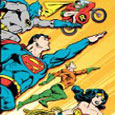Hanna-Barbera (1973), Warner Home Video (January 5, 2010), 2 discs, 360 mins plus supplements, 1.33:1 original full frame ratio, Dolby Digital Mono, Not Rated, Retail: $26.98
Storyboard:
The Justice League plays nice in this kid-friendly adaptation of the world’s greatest superheroes.

The Sweatbox Review:
Oh, what ye did wrought!
One wonders where the world of popular entertainment would be now without Super Friends. Seriously. The show ended up being a massive influence on a whole generation of kids, kids who became today’s Hollywood producers, cartoon makers, and comic book writers and artists. (Just imagine— we might never have had painter Alex Ross working in comics at all!) Additionally, those TV viewers of yesterday became adult viewers of today, not to mention movie attendees, and they are now parents of a new superhero-happy generation. There were a handful of shows that preceded Super Friends (The Superman-Aquaman Hour even had an occasional Justice League Of America segment), but none of them had nearly as many seasons on the air as did Super Friends. Hard to believe, then, that the show was initially cancelled after its initial set of 16 episodes. It was only once it hit reruns that it captured a suitable audience that allowed for a renewal.
For the record, I’m a died-in-the-wool DC Comics fan. I have always loved these characters, ever since seeing George Reeves and Adam West on reruns in the late 1970s. At my then-young age, I did not realize that the Batman show was a comedy, that West’s desperately intense delivery of his lines was actually an over-the-top put-on. Now that I can watch the show with older eyes, though, I still think that it was the absolutely coolest show to ever air on television. Even those who hate it have to admit that it was in many ways absolutely faithful to the comic books, and I still have an appreciation for superhero costumes that are not presented as being made up of black leather or rubber. The 1950’s Adventures of Superman, on the other hand, was brilliant in its presentation of Superman as fantastic yet down-to earth, and it was Reeves that first made me believe that a man could fly; after all, I was too young to know that the halo around him on processed shots was not intentional— maybe Superman really did glow when he flew!
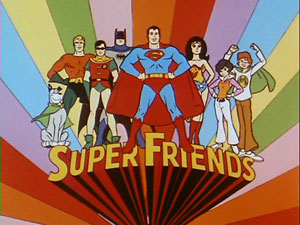
And then my family finally got cable, which meant more American television, and I discovered Super Friends. Wow! Apparently, there was a whole world full of superheroes, and they had all teamed up together to fight crime! This was incredible! My mind having been fully blown, I was converted for good, and as my reading skills improved I began to devour the comic book adventures of these characters. My favorites then were DC Comics Presents and The Brave And The Bold, which presented Superman and Batman team-up stories respectively; and World’s Finest Comics, which at the time carried a Superman/Batman team-up, plus had several other superhero features. Then, of course, there was Justice League Of America, which Super Friends was based on, and its wonderful summer team-ups with the Justice Society Of America. I credit those comic books with my development of a large vocabulary at a tender age, and for helping me develop a strong moral sense. I read lots of sci-fi novels and Hardy Boys back then too, but it was the comics that spoke to my soul. And it all started with George Reeves, Adam West, and Super Friends.
My earliest memories of Super Friends are actually those of The All-New Super Friends Hour. Little did I realize then that there had been an earlier version of the show…
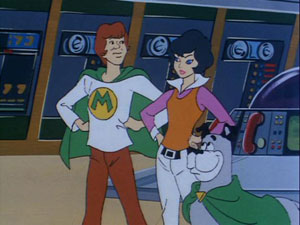
Having had success already with Jonny Quest (1964) and The Fantastic Four (1967), Hanna-Barbera was looking for another adventure hit. As this followed the time of the late 1960s backlash against violent cartoons, Hanna-Barbera planned to make their shows less violent and more moralistic. They still remembered the overwhelming ratings success that Filmation had had with The Adventures Of Superman (beginning in 1966), and so they looked at doing their own adaptation of DC’s heroes. They did a pilot of sorts when they guest-starred Batman and Robin in two 1972 episodes of The New Scooby Doo Movies. This proved to be ratings magic, and led to those heroes joining Superman, Aquaman (still riding that freakish, gigantic seahorse that he had in his Filmation show) and Wonder Woman as the Super Friends in 1973. This was essentially a pared-down version of the Justice League of America, with a less imposing name and a kid sidekick (Robin was never an official JLA member in the comics; and he was not even mentioned in the opening of the show, which only proclaimed “four” of the world’s greatest heroes). The opening, incidentally, did verbally identify the team as the Justice League Of America. New sidekicks were added, too, for “audience identification”— the Junior Super Friends, who included green-caped Marvin, Bruce Wayne’s niece Wendy, and Wonder Dog (also in a green cape). Marvin and the Scooby Doo-like Wonder Dog in particular also served as goofy comic relief, although Robin was also cracking puns and “Holy this, holy that”. The team met at the Hall Of Justice, rather than a cave or satellite as was seen in the comics. Ted Knight gave intensely sincere narration, and the character design was by comic book legend and HB animation veteran Alex “Space Ghost” Toth.

The largely sub-par animation was mainly produced in Australia. The hour-long stories used corny dialog, somewhat wonky plots and earnest yet thin characterization. There were aliens like the Balloon People, misguided scientists like Dr. Gulliver and Dr. Rebos, and villains like King Plasto. All in all, it was not an impressive roster of foes. There were super guest stars, though, like The Flash, Green Arrow, and Plastic Man. The show lasted two seasons, and then was brought back as a mid-season replacement in January, 1976. A half-hour version then pulled in better ratings, and the show was revived in 1977 as The All-New Super Friends Hour, at the unheard-of time of 6:30am. It was a smash hit, and with more new shows being ordered, various incarnations of Super Friends would run until 1985, making it one of the most successful Saturday morning cartoons ever.

Warner Home Video has already released most versions of the show, beginning with single disc releases (and later a complete series set) for Challenge Of The Superfriends. From there, they went forward in time, delivering the final, toy-inspired seasons of the show, before giving fans the All New version, and a sampling of “lost” episodes. And all along, many of us asked when the heck Warner would give us the very first season— the one that started it all? Perhaps they had less faith in its ability to generate sales, but whatever the reason they waited until now; and at last we can see, for better or worse, the Wendy and Marvin episodes.
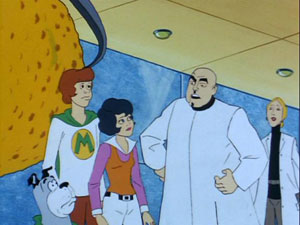
Legend has had it that these episodes simply were not very good, but in truth they are no worse than those found in future seasons. Well, it is true that they dragged their thin plots over a full hour, but that also left more room for all the characters to shine. The animation quality is no better or worse than what came later, with limited animation appearing hurried and not always all that skilled, not to mention the usual painting mistakes. The main drawback of the show isn’t necessarily Wendy and Marvin, either; their lack of superpowers (except for some little-seen limited flight capability from Marvin) makes them no less worthy than Batman and Robin, and the use of Marvin and Wonder Dog for comedy relief is not more disagreeable than how the Wonder Twins and their space monkey Gleek would be used in later seasons. Instead, the worst thing that can be said for the first season of Super Friends is that, for a superhero show, there wasn’t a whole lot of evil to fight. Rather, the team faced off against an assortment of careless scientists and misguided aliens. No one is really allowed to throw a punch, and those hoping to see violence will have to settle for some light jeopardy and philosophical disagreement.
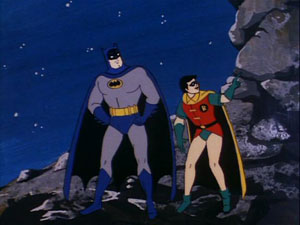
This DVD set contains the first eight, hour-long episodes.
Disc 1
The Power Pirate – The Super Friends prevent various catastrophes that result from an alien being siphoning power from across the globe. Of course, the aliens aren’t really all that bad, and the Super Friends manage to help them in the end.
The Baffles Puzzle – Professor Baffles threatens the world’s leaders, and when they do not capitulate, he begins making things disappear— works of art, money, and the like (one wonders why he didn’t just steal them in the first place). Wendy follows a lead, and she and Marvin are captured (a recurring theme in the show), and they need a rescue.
Professor Goodfellow’s G.E.E.C. – In an effort to decrease the amount of labor needed in the world, Professor Goodfellow creates Goodfellow’s Effort Eliminating Computer. Alas, all of his good will goes to waste when a mouse gets into the works and causes the computer to badly malfunction. Plastic Man (in his very first animation appearance) briefly guest stars to get the pesky mouse, and Professor Goodfellow learns that it’s okay for people to have to do some work.
The Weather Maker – A poor, mad scientist tries to warm up his homeland of Glacia by diverting the Gulf stream north, thereby— whoops!— causing the rest of the world to freeze. Don’t worry, the Super Friends will straighten him out.
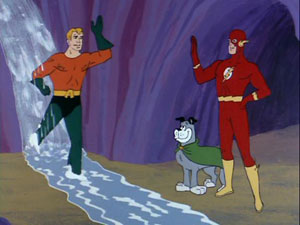
Disc 2
Dr. Pelagian’s War – An environmentalist named Dr. Pelagian attempts to pressure a number of industrialists into agreeing to stop their unchecked polluting of the environment. The industrialists are so selfish and stubborn it almost makes you cheer for Dr. Pelagian.
The Shamon ‘U’ – A team of scientists, led by Dr. Simeon Shamon, mine minerals from the sky with the use of a powerful electromagnet. Shamon doesn’t heed a warning from a colleague about the potential dangers, and the space dust ends up causing objects across the globe to grow or shrink. Dr. Shamon’s a good egg, however, and is sorry that he caused so much trouble for everyone.
Too Hot To Handle – Another alien menace comes to Earth and forgets to ask anyone permission before messing things up. This time, the Earth is moved closer to the sun in order to make for a new warm, suitable home world for the aliens. The Flash helps the Super Friends move the Earth back, and the team once again decides to help out the poor alien folk.
The Androids – Yet another mad scientist, this time named Dr. Rebos, uses his robots to disrupt the space program. In response to interference from the Super Friends, he creates a Superman android to destroy a Mars space station.
It may not be fine art, but any time the Super Friends head to the TroubAlert in the Hall Of Justice, you know you’re in for a good time.

Is This Thing Loaded?
Apparently, just finally getting this first season is supposed to be enough to satisfy us collectors, as no substantial special features have been included. Granted, some of the past featurettes have been fairly lame, but this would have been a great opportunity to get something of an overview of the show. Instead, all we get is The Super Friends Trivia Challenge. It’s okay, and would have been adequate as the second or third bonus feature, but as the solitary one it comes off as distinctly under-whelming. The questions, at least, do actually provide some challenge, based as they are on the comic book characters more than the TV show.
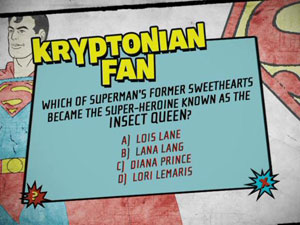
At least the episodes do have chapter stops, though there’s no menu for them. Previews include Crisis On Two Earths, Halo Legends, and You’re A Good Man, Charlie Brown on Disc One; and there is one on Disc Two for the Saturday Morning Cartoon collections.
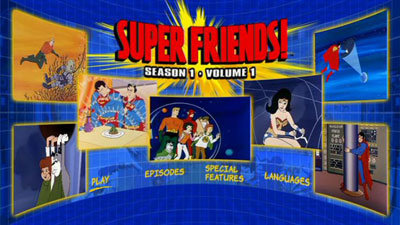
Case Study:
As I look at my Super Friends DVD shelf, I now see three different methods of packaging (I no longer have the old single disc releases, which came in the dreaded snapper cases), and wistfully think about how nice it would be if Warner Home Video had observed any consistency. Like the fairly recent “Lost Episodes” package, this two-disc set comes in a standard Amaray case with a tray, all housed inside an identical slipcase. It is disappointing that the artwork does not reflect which version of the show the package contains, featuring only generic artwork that appears to be the (very good) work of Jose Luis Garcia Lopez, who for years has contributed to the DC Comics licensing style guides. Though Lopez is extremely talented, it would have been so much more appropriate to use the classic Alex Toth artwork that all fans adore, preferably including Wendy, Marvin, and Wonder Dog. There are no insets in the case.

Ink And Paint:
I doubt that these shows had any serious restoration work, but they actually look reasonably decent. Transfers are a bit on the soft side, sometimes faded, and the prints do have a fair amount of issues with dust and scratches, but for the most part the show looks a little better than I expected. I can be forgiving of an old cartoon show like this, and as such I’m satisfied.

Scratch Tracks:
Good ol’ mono sound, just like what I enjoyed as a kid. Nothing wrong with that. The tracks are clear and non-problematic. There is only the English soundtrack, and English subtitles.
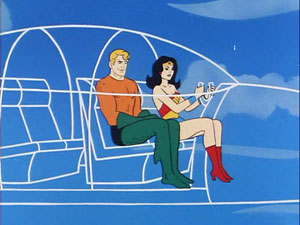
Final Cut:
Anyone who has kept up with all the various DVD releases of Super Friends should be glad to see the original version finally come to disc. The show was never brilliant (or even all that well done), but it is good, wholesome fun. This release seems a little haphazard, with generic cover art and a lack of bonus material, but I’ll take what I can, I guess. It’s finally a chance to catch the Wendy and Marvin episodes, and to see what started the whole phenomenon off.
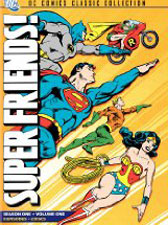 | ||
 |


